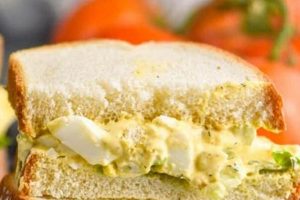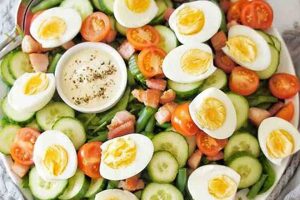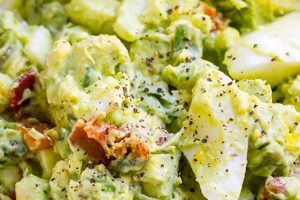A chilled dish featuring chopped hard-boiled eggs bound with mayonnaise is elevated with the fresh, herbaceous flavor of dill. Variations may include other ingredients like mustard, celery, onion, or seasonings such as paprika or black pepper. This dish is commonly served as a sandwich filling, a salad topping, or enjoyed with crackers or crudits.
This combination of ingredients offers a balance of protein, healthy fats, and vibrant flavor. The simplicity of preparation makes it an ideal choice for quick lunches, picnics, or potlucks. Historically, egg salad has been a popular dish due to its affordability and versatility, and the addition of dill provides a distinctive twist on a classic. The refreshing nature of the herb makes it especially appealing during warmer months.
This exploration will delve into variations on the basic formula, offering insights into ingredient selection, preparation techniques, and presentation suggestions. Further topics will cover nutritional information, storage advice, and creative serving ideas.
Tips for an Exceptional Egg Salad with Dill
Elevating egg salad with dill requires attention to detail and a thoughtful approach to ingredient selection and preparation. The following tips offer guidance for achieving optimal flavor and texture.
Tip 1: Egg Cooking Technique: Perfectly cooked eggs are essential. Overcooked yolks can become dry and crumbly. A recommended method involves placing eggs in a saucepan, covering them with cold water, bringing the water to a rolling boil, then removing the pan from heat and letting the eggs sit in the hot water for 10-12 minutes, depending on size. Immediately transfer the eggs to an ice bath to stop the cooking process.
Tip 2: Dill Selection and Preparation: Fresh dill offers the most vibrant flavor. Finely chop the dill just before incorporating it into the salad to maximize its aromatic impact. Dried dill can be substituted if fresh is unavailable, but use about one-third the amount.
Tip 3: Mayonnaise Selection: High-quality mayonnaise contributes significantly to the overall flavor profile. Consider using mayonnaise made with olive oil for a richer taste.
Tip 4: Balancing Flavors: A touch of acidity brightens the salad. A small amount of lemon juice, white wine vinegar, or Dijon mustard can achieve this balance.
Tip 5: Texture Considerations: A coarse chop of the eggs provides a pleasant textural contrast to the creamy mayonnaise. Alternatively, a finer chop creates a smoother, more uniform texture.
Tip 6: Ingredient Incorporation: Gently fold the ingredients together to avoid overmixing and breaking down the egg pieces.
Tip 7: Chilling Time: Allowing the salad to chill in the refrigerator for at least 30 minutes before serving allows the flavors to meld.
By following these tips, one can create an egg salad with dill that is both flavorful and visually appealing, transforming a simple dish into a culinary delight.
These insights provide a foundation for crafting a personalized version of this versatile dish, catering to individual preferences and dietary needs. The following section will offer concluding remarks and suggest further exploration.
1. Fresh Dill
Fresh dill plays a pivotal role in a dill egg salad recipe, contributing a bright, herbaceous flavor and aroma that distinguishes it from traditional egg salad. The volatile oils present in fresh dill are responsible for its distinctive taste, which is often described as slightly tangy, subtly sweet, and anise-like. These oils are most potent when the dill is fresh, diminishing with drying or prolonged storage. Using fresh dill significantly elevates the sensory experience of the egg salad. For instance, a dill egg salad sandwich made with fresh dill offers a burst of flavor that complements the richness of the mayonnaise and the subtle taste of the eggs. Conversely, using dried dill, while acceptable, results in a less pronounced and somewhat muted flavor profile.
The practical significance of using fresh dill lies in its ability to transform a simple egg salad into a more complex and flavorful dish. This freshness adds a dimension that dried dill simply cannot replicate. The vibrant green color of fresh dill also enhances the visual appeal of the egg salad, making it more appetizing. Furthermore, fresh dill can be easily incorporated into the recipe, requiring only a simple chop before being mixed with the other ingredients. This ease of use, combined with its significant impact on flavor and appearance, underscores the importance of fresh dill in a dill egg salad recipe. Consider a summer picnic scenario: the fresh dill in the egg salad sandwiches provides a refreshing counterpoint to the heavier picnic fare, enhancing the overall meal experience.
In summary, the use of fresh dill is a key differentiator in a dill egg salad recipe. Its vibrant flavor, aroma, and visual appeal contribute significantly to the overall sensory experience. While dried dill can be used as a substitute, it does not deliver the same intensity of flavor or visual impact. Therefore, opting for fresh dill is highly recommended for anyone seeking to create a truly exceptional dill egg salad. The choice highlights an understanding of flavor dynamics and showcases an appreciation for fresh, high-quality ingredients.
2. Perfectly Cooked Eggs
The foundation of a successful dill egg salad rests upon the quality of its core ingredient: eggs. Perfectly cooked eggs contribute not only optimal texture but also enhance the overall flavor profile of the dish. Overcooked eggs result in a dry, crumbly texture and a chalky taste, detracting from the desired creamy consistency and delicate flavor balance. Conversely, undercooked eggs present food safety concerns and an unpleasant, runny texture. The following facets explore the critical role of perfectly cooked eggs in a dill egg salad recipe.
- Texture and Mouthfeel
Properly cooked eggs offer a firm yet tender texture, providing a pleasant contrast to the creamy mayonnaise and the crispness of the dill. This textural interplay is essential for a balanced and enjoyable culinary experience. Overcooked yolks, on the other hand, create a grainy, dry salad, while undercooked whites contribute an undesirable sliminess. Imagine biting into a dill egg salad sandwich; the gentle resistance of the egg pieces against the creamy mayonnaise contributes significantly to satisfaction.
- Flavor Enhancement
Perfectly cooked eggs allow their subtle, naturally sweet flavor to shine through, harmonizing with the other ingredients without being overpowered. Overcooking diminishes this delicate flavor, leaving a bland, almost sulfurous taste. This subtle sweetness complements the herbaceous dill and the richness of the mayonnaise, creating a balanced flavor profile. A well-executed egg salad provides a nuanced interplay of flavors, rather than a single dominant note.
- Visual Appeal
The appearance of the egg salad also benefits from properly cooked eggs. A vibrant, creamy yellow yolk is visually appealing and signals freshness. Overcooked yolks appear pale and dry, detracting from the overall aesthetic. Consider the presentation of the egg salad: bright yellow yolks nestled amongst the green dill and creamy mayonnaise create an appetizing visual experience. This visual aspect contributes to the overall enjoyment of the dish.
- Food Safety
Ensuring eggs are cooked to a safe internal temperature eliminates the risk of salmonella contamination. This is a critical consideration for any dish involving eggs. Proper cooking techniques, such as bringing the eggs to a rolling boil and then allowing them to sit in hot water off the heat for a specific time, guarantee both food safety and optimal texture. Adherence to safe cooking practices is paramount in any culinary endeavor involving eggs.
The importance of perfectly cooked eggs in a dill egg salad recipe cannot be overstated. From texture and flavor to visual appeal and food safety, the proper cooking of eggs is paramount. Mastering this fundamental step ensures a delightful and safe culinary experience. This attention to detail elevates the dill egg salad from a simple dish to a carefully crafted creation, showcasing the importance of fundamental cooking techniques.
3. High-Quality Mayonnaise
Mayonnaise serves as the unifying element in dill egg salad, binding the ingredients and contributing significantly to the overall flavor and texture. High-quality mayonnaise elevates this simple dish, offering a richer, more nuanced experience compared to generic alternatives. The following facets explore the crucial role of high-quality mayonnaise in a dill egg salad recipe.
- Flavor Profile
High-quality mayonnaise possesses a balanced flavor profile characterized by a creamy richness, a subtle tanginess, and a clean finish. This complexity complements the delicate flavor of the eggs and the herbaceous notes of the dill. Generic mayonnaise often relies on excessive sweetness or artificial flavors, which can mask the other ingredients and create an unbalanced taste. Consider the difference between tasting fresh lemon juice versus an artificial lemon flavoring; the nuance and depth of the natural ingredient significantly enhance the overall culinary experience.
- Texture and Emulsification
A stable emulsion is crucial for a smooth and creamy egg salad. High-quality mayonnaise, typically made with egg yolks and a good quality oil, creates a stable emulsion that prevents the salad from becoming watery or separating. This stability contributes to a pleasant mouthfeel and prevents the sandwich filling from becoming soggy. Imagine the textural difference between a smooth, creamy egg salad and one that is oily and separated; the quality of the mayonnaise directly impacts this aspect.
- Ingredient Quality
High-quality mayonnaise utilizes superior ingredients, such as fresh eggs, high-grade oils (like extra virgin olive oil or avocado oil), and natural flavorings. These ingredients contribute not only to better flavor but also to potential health benefits. Generic mayonnaise may contain artificial ingredients, preservatives, and lower quality oils, impacting both the taste and nutritional value. Comparing ingredient lists often reveals significant differences in quality and highlights the potential impact on overall health and flavor.
- Complementary Role
High-quality mayonnaise acts as a canvas for the other flavors in the dill egg salad, enhancing rather than overpowering them. It allows the subtle sweetness of the eggs and the bright, herbaceous notes of the dill to shine through. This complementary role ensures a balanced and harmonious flavor profile. Consider a symphony orchestra: each instrument plays its part, but the conductor (mayonnaise) brings them together to create a cohesive and beautiful piece of music.
The choice of mayonnaise significantly impacts the overall quality of dill egg salad. High-quality mayonnaise provides a superior foundation for flavor, texture, and visual appeal. Investing in a premium product elevates the dish from simple to exceptional, showcasing an appreciation for quality ingredients and their impact on the final product. This attention to detail transforms the everyday egg salad into a culinary experience that is both satisfying and memorable.
4. Complementary Seasonings
Complementary seasonings play a crucial role in elevating dill egg salad beyond a simple combination of ingredients. These seasonings enhance the inherent flavors of the eggs, mayonnaise, and dill, adding depth and complexity. Careful consideration of these seasonings allows for customization and balances the overall flavor profile. The interaction between these seasonings creates a symphony of flavors that transforms the dish.
Classic additions such as black pepper offer a subtle heat and bite, contrasting with the creamy mayonnaise and refreshing dill. A pinch of paprika introduces a smoky warmth, while a touch of cayenne pepper provides a more pronounced heat. The interplay between these spices creates a balanced flavor profile, enhancing the overall sensory experience. For instance, the slight bitterness of black pepper offsets the richness of the mayonnaise, while the smokiness of paprika adds a layer of complexity. These seemingly small additions can dramatically impact the final product, transforming a basic egg salad into a nuanced culinary creation.
Beyond traditional spices, the inclusion of ingredients like finely diced red onion or chives introduces textural and flavor contrasts. Red onion contributes a sharp, pungent bite, while chives offer a delicate onion flavor with a hint of garlic. These additions create a multi-dimensional sensory experience, engaging both the palate and the olfactory senses. Consider the interplay between the crispness of the red onion and the creaminess of the egg salad; the textural contrast adds another layer of enjoyment. Furthermore, the aromatic properties of chives enhance the overall sensory experience, contributing a subtle yet distinct fragrance.
Understanding the interplay of complementary seasonings enables one to create a dill egg salad tailored to individual preferences. Whether seeking a subtly spiced salad or one with a more pronounced flavor profile, the judicious use of seasonings is key. This knowledge allows for experimentation and customization, resulting in a dish that is both flavorful and personalized. The seemingly simple act of adding a pinch of this or a dash of that transforms the egg salad from a basic dish into a culinary expression, reflecting individual tastes and preferences. This ability to customize and adapt the recipe underscores the importance of understanding complementary seasonings in the context of a dill egg salad.
5. Proper Egg Chopping
Proper egg chopping significantly influences the final texture and overall enjoyment of dill egg salad. The size of the egg pieces affects mouthfeel, the distribution of flavor, and the structural integrity of the salad. A coarse chop, achieved by roughly dicing the eggs, yields a chunkier salad with distinct textural variation. This approach allows individual egg pieces to retain their shape and provides a more substantial bite. Conversely, a fine chop, achieved by mincing or mashing the eggs, creates a smoother, more uniform texture. This method results in a creamier consistency where the egg is more thoroughly integrated with the other ingredients. The choice between these techniques depends on individual preference and the desired final product.
Consider the practical implications of chop size. A coarsely chopped egg salad provides a more substantial, satisfying texture, particularly when served in sandwiches. The larger egg pieces offer a noticeable textural contrast to the bread and other fillings. This is advantageous for those who prefer a heartier sandwich experience. In contrast, a finely chopped egg salad lends itself well to applications where a smoother consistency is desired, such as spreads for crackers or canaps. The finer texture allows for easier spreading and a more delicate mouthfeel. Furthermore, the degree of chopping influences how the flavors meld. A coarse chop allows the distinct flavor of the egg to remain prominent, while a fine chop distributes the egg flavor more evenly throughout the salad, resulting in a more homogenous taste experience. For instance, if showcasing the quality of farm-fresh eggs is a priority, a coarser chop might be preferred.
Achieving the desired chop requires attention to technique. Using a sharp knife and a consistent cutting motion ensures uniformity. For a coarse chop, a gentle rocking motion with the knife is recommended. For a fine chop, a methodical back-and-forth motion is more effective. Over-chopping should be avoided, as this can result in a mushy texture. Understanding the impact of egg chopping allows for deliberate control over the final product, contributing significantly to the overall enjoyment of dill egg salad. This seemingly minor detail demonstrates an attention to culinary technique that elevates the dish beyond a simple mixture of ingredients, showcasing the transformative power of proper preparation. This awareness allows one to tailor the salad’s texture to complement specific serving methods and individual preferences, demonstrating a mastery of culinary technique and a deep understanding of the interplay between texture and flavor.
6. Balanced Flavor Profile
A balanced flavor profile is paramount in a successful dill egg salad recipe. It distinguishes a bland, forgettable salad from a vibrant, memorable one. This balance hinges on the harmonious interplay of key flavor components: richness, acidity, freshness, and seasoning. A well-balanced dill egg salad engages the palate with a symphony of complementary tastes, rather than a single dominant note. This exploration delves into the essential facets of achieving this balance.
- Richness from Mayonnaise and Egg Yolks
Mayonnaise contributes the foundational richness to dill egg salad. High-quality mayonnaise, preferably made with good oils, offers a creamy, luxurious mouthfeel. This richness is further amplified by the egg yolks, which provide a natural fattiness and subtle sweetness. This element is crucial for creating a satisfying and palate-coating experience. However, excessive richness can be overwhelming. Imagine the difference between a spoonful of pure mayonnaise and a dollop of perfectly balanced dill egg salad; the balance of flavors prevents the richness from becoming cloying.
- Acidity as a Brightening Agent
Acidity plays a vital role in cutting through the richness of the mayonnaise and egg yolks, preventing the salad from becoming heavy or overly dense. A touch of lemon juice, vinegar, or a dash of Dijon mustard introduces a refreshing tartness that brightens the overall flavor profile. This acidity enhances the other flavors, allowing the herbaceous notes of the dill and the subtle sweetness of the eggs to shine through. Think of adding a squeeze of lemon to grilled fish; the acidity enhances the flavor of the fish without overpowering it. Similarly, in dill egg salad, acidity provides a necessary counterpoint to the richness.
- Freshness from Dill
Fresh dill contributes the signature herbaceous element to the flavor profile. Its bright, slightly tangy, and subtly anise-like flavor provides a refreshing counterpoint to the richness of the mayonnaise and eggs. The dill’s aromatic oils contribute a vibrant freshness, elevating the salad beyond a simple combination of ingredients. Compare the flavor of fresh dill to dried dill; the fresh herb offers a vibrant burst of flavor that dried dill simply cannot replicate. This freshness is essential for a balanced and complex flavor profile.
- Seasoning for Depth and Complexity
Seasoning enhances and complements the core flavors of the dill egg salad. Salt enhances the natural flavors of the ingredients, while black pepper adds a subtle heat and complexity. Other seasonings, such as paprika or cayenne pepper, can introduce additional layers of flavor, depending on personal preference. However, over-seasoning can easily mask the delicate flavors of the eggs and dill. The careful and balanced use of seasonings adds depth and nuance without overpowering the other components. Consider the way a chef seasons a delicate sauce; a pinch of salt can enhance the flavors, while too much can ruin the entire dish. The same principle applies to seasoning dill egg salad.
A balanced flavor profile is the hallmark of a well-executed dill egg salad. The interplay of richness, acidity, freshness, and seasoning creates a harmonious blend of flavors that tantalizes the taste buds. This balance is not accidental; it requires careful consideration of each ingredient and its contribution to the overall flavor profile. Achieving this balance elevates the dish from simple to exceptional, showcasing a nuanced understanding of flavor dynamics and a commitment to culinary excellence. The balanced flavor profile of a dill egg salad demonstrates a mastery of flavor principles, transforming a simple dish into a sophisticated culinary experience.
7. Adequate Chilling Time
Adequate chilling time is a crucial, yet often overlooked, element in a dill egg salad recipe. It significantly impacts the final flavor profile and overall enjoyment of the dish. Chilling allows the individual flavors of the ingredientseggs, mayonnaise, dill, and any additional seasoningsto meld and harmonize, creating a more cohesive and complex flavor experience. This process, driven by temperature reduction and ingredient interaction, transforms a simple mixture into a balanced and nuanced culinary creation. Without sufficient chilling time, the flavors remain disparate, resulting in a less satisfying and potentially bland egg salad. The chemical processes involved in flavor development are temperature-dependent; lower temperatures slow down reactions, allowing for a more gradual and complete integration of flavors. Consider the difference between freshly brewed coffee and coffee that has been sitting on a burner for hours; the latter often develops bitter and unpleasant flavors due to prolonged exposure to heat. Similarly, allowing the dill egg salad to chill allows the flavors to mature and harmonize without becoming muddled.
The practical implications of adequate chilling are numerous. Chilling firms the egg salad, making it easier to handle and spread, whether for sandwiches, crackers, or other applications. This structural improvement enhances the overall presentation and eating experience. Imagine trying to spread freshly made egg salad on bread; the mixture would likely be too loose and difficult to manage. Chilling solves this practical challenge. Furthermore, chilling enhances food safety by slowing bacterial growth. This is particularly important for dishes containing mayonnaise, a perishable ingredient. Proper chilling ensures the egg salad remains safe for consumption and extends its shelf life. This food safety aspect is paramount in any culinary endeavor.
Chilling time should be viewed not merely as a storage step, but as an integral part of the recipe itself. A minimum of 30 minutes is generally recommended, but longer chilling times, up to a few hours, can further enhance flavor development. The precise duration depends on the specific recipe and the ambient temperature. This understanding of the crucial role of chilling time transforms the perception of dill egg salad preparation from a simple mixing task into a more nuanced culinary process. The attention to detail, including adequate chilling, demonstrates a commitment to culinary excellence and a deep understanding of the factors that contribute to a truly exceptional dish. By recognizing the transformative effect of adequate chilling, one elevates the dill egg salad from a basic preparation to a carefully crafted culinary experience.
Frequently Asked Questions
This section addresses common inquiries regarding dill egg salad preparation, offering concise and informative responses.
Question 1: How long can dill egg salad be stored safely?
Properly stored in an airtight container in the refrigerator, dill egg salad typically remains safe for consumption for up to 3-5 days. Beyond this timeframe, the risk of bacterial growth increases significantly. Visual inspection and odor assessment are crucial before consumption; discard the salad if any off-odors or discoloration are present.
Question 2: Can dried dill be substituted for fresh dill?
While fresh dill is ideal for its vibrant flavor and aroma, dried dill can be used as a substitute if fresh dill is unavailable. However, the quantity should be adjusted; approximately one teaspoon of dried dill is equivalent to one tablespoon of fresh dill. Dried dill tends to have a more concentrated, slightly different flavor profile compared to fresh dill.
Question 3: What types of bread are best suited for dill egg salad sandwiches?
A variety of breads complement dill egg salad. Classic choices include white bread, whole wheat bread, rye bread, and sourdough bread. For a lighter option, consider croissants or baguettes. The bread choice often depends on individual preference and desired texture combinations.
Question 4: How can one prevent dill egg salad from becoming watery?
Watery dill egg salad often results from over-chopping the eggs or using excessive mayonnaise. To prevent this, ensure the eggs are chopped to the desired consistency without being overly processed. Use high-quality mayonnaise and incorporate it gradually, adjusting the amount according to the desired texture. Adequate chilling time also helps the salad firm up and prevents excess moisture.
Question 5: What are some alternative ways to serve dill egg salad besides sandwiches?
Dill egg salad offers versatility beyond sandwiches. It can be served as a filling for lettuce wraps, a topping for salads, or a dip for crackers or crudits. It can also be used as a stuffing for deviled eggs or tomatoes. These alternatives provide varied presentations and cater to different dietary preferences.
Question 6: Can dill egg salad be frozen?
Freezing dill egg salad is not recommended. The mayonnaise base separates upon thawing, resulting in an undesirable texture and potentially compromised flavor. The delicate texture of the eggs also suffers during freezing, leading to a less enjoyable culinary experience. It is best to prepare and consume dill egg salad fresh.
These responses offer practical guidance for preparing and enjoying dill egg salad. Attention to detail, from ingredient selection to storage practices, ensures a successful and satisfying culinary outcome.
The following section will offer concluding thoughts and suggest further exploration of this versatile dish.
Dill Egg Salad Recipe
Exploration of the dill egg salad recipe reveals a dish exceeding simple categorization as a mere mixture of ingredients. Careful consideration of individual componentsfresh dill, perfectly cooked eggs, high-quality mayonnaise, complementary seasonings, proper egg chopping, a balanced flavor profile, and adequate chilling timedemonstrates the potential for culinary refinement. Each element contributes significantly to the final product, impacting texture, flavor, and overall enjoyment. Understanding the interplay of these components allows for customization and elevates the dish from basic to exceptional.
The synthesis of these elements transforms the dill egg salad recipe into an opportunity for culinary expression. Attention to detail, from ingredient selection to preparation techniques, unlocks the full potential of this versatile dish. Further exploration and experimentation with variations, such as incorporating different herbs, spices, or textural elements, promises continued culinary discovery and enjoyment. The potential for creative adaptation underscores the enduring appeal of the dill egg salad recipe, positioning it as a canvas for culinary innovation and personal expression within the realm of classic cuisine.






